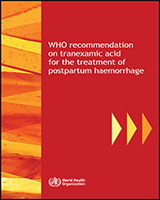All rights reserved. Publications of the World Health Organization are available on the WHO web site (www.who.int) or can be purchased from WHO Press, World Health Organization, 20 Avenue Appia, 1211 Geneva 27, Switzerland (tel.: +41 22 791 3264; fax: +41 22 791 4857; e-mail: tni.ohw@sredrokoob). Requests for permission to reproduce or translate WHO publications - whether for sale or for noncommercial distribution - should be addressed to WHO Press through the WHO web site (http://www.who.int/about/licensing/copyright_form/en/index.html).
NCBI Bookshelf. A service of the National Library of Medicine, National Institutes of Health.
This publication is provided for historical reference only and the information may be out of date.
Overview
Postpartum haemorrhage (PPH) is a major cause of mortality, morbidity and long term disability related to pregnancy and childbirth. Effective interventions to prevent and treat PPH exist and can largely reduce the burden of this life-threatening condition.
Given the availability of new scientific evidence related to the prevention and treatment of PPH, this document updates previous WHO recommendations and adds new recommendations for the prevention and treatment of PPH. The primary goal of this guideline is to provide a foundation for the implementation of interventions shown to have been effective in reducing the burden of PPH. Health professionals responsible for developing national and local health policies constitute the main target audience of this document. Obstetricians, midwives, general medical practitioners, health care managers and public health policy-makers, particularly in under-resourced settings are also targeted. This document establishes general principles of PPH care and it is intended to inform the development of clinical protocols and health policies related to PPH.
Contents
- Acknowledgements
- Abbreviations
- Executive summary
- 1. Background
- 2. Methods
- 3. Results
- 4. Research implications
- 5. Dissemination and implementation of the guideline
- 6. Applicability issues
- 7. Updating the guideline
- References
- Annex 1 External experts, WHO staff involved in the preparation of the guideline, and summary of declarations of interest
- Annex 2 Critical outcomes for decision making
- Annex 3 Summary of the considerations related to the strength of the recommendations (Balance Worksheets)
- Evidence base
The designations employed and the presentation of the material in this publication do not imply the expression of any opinion whatsoever on the part of the World Health Organization concerning the legal status of any country, territory, city or area or of its authorities, or concerning the delimitation of its frontiers or boundaries. Dotted lines on maps represent approximate border lines for which there may not yet be full agreement.
The mention of specific companies or of certain manufacturers' products does not imply that they are endorsed or recommended by the World Health Organization in preference to others of a similar nature that are not mentioned. Errors and omissions excepted, the names of proprietary products are distinguished by initial capital letters.
All reasonable precautions have been taken by the World Health Organization to verify the information contained in this publication. However, the published material is being distributed without warranty of any kind, either expressed or implied. The responsibility for the interpretation and use of the material lies with the reader. In no event shall the World Health Organization be liable for damages arising from its use.
- Review WHO recommendations: Uterotonics for the prevention of postpartum haemorrhage[ 2018]Review WHO recommendations: Uterotonics for the prevention of postpartum haemorrhage. 2018
- Review WHO Recommendations for Augmentation of Labour[ 2014]Review WHO Recommendations for Augmentation of Labour. 2014
- Review WHO recommendations: Intrapartum care for a positive childbirth experience[ 2018]Review WHO recommendations: Intrapartum care for a positive childbirth experience. 2018
- Interpretation of national policy regarding community-based use of misoprostol for postpartum hemorrhage prevention in Ethiopia: a tale of two regions.[J Midwifery Womens Health. 2014]Interpretation of national policy regarding community-based use of misoprostol for postpartum hemorrhage prevention in Ethiopia: a tale of two regions.Spangler SA, Gobezayehu AG, Hailemariam TG, Sibley LM. J Midwifery Womens Health. 2014 Jan; 59 Suppl 1:S83-90.
- Review WHO Recommendations for Prevention and Treatment of Maternal Peripartum Infections[ 2015]Review WHO Recommendations for Prevention and Treatment of Maternal Peripartum Infections. 2015
- WHO Recommendations for the Prevention and Treatment of Postpartum HaemorrhageWHO Recommendations for the Prevention and Treatment of Postpartum Haemorrhage
Your browsing activity is empty.
Activity recording is turned off.
See more...

